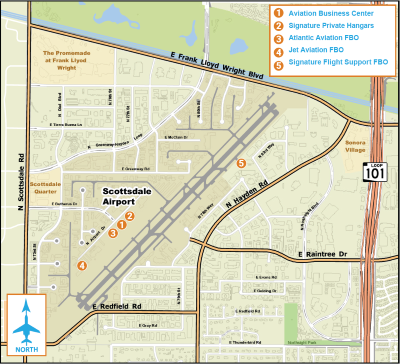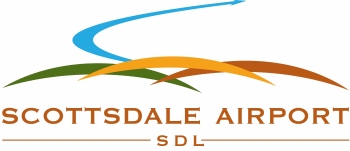Noise Abatement Rules & Procedures
Noise Abatement Procedures
Prohibited Procedures:
- Intersection takeoffs, stop-and-go, formation, simulated single engine departures or go-arounds prohibited.
- Touch-and-go operations prohibited between 9:30 p.m. and 6 a.m.
- Engine maintenance runups prohibited between 10 p.m. and 7 a.m., except in emergencies.
- Runway weight restriction is 75,000 lbs. maximum certificated takeoff weight. Aircraft Operations between 75,000 lbs. and 100,000 lbs. must secure P.P.R., call Airport Operations at 480-312-8478 for more information.
Preferred Procedures:
Compliance with recommended noise abatement procedures are at the pilot's discretion.SAFETY ALWAYS COMES FIRST.
- Voluntary Curfew - 10 p.m. - 6 a.m.
- Runway 3 is the designated calm wind runway, and preferred noise abatement runway.
- When departing Runway 21 make right turn to 300 degrees as soon as possible, or make a climbing full 270 degree right turn before heading east or southbound.
- Aircraft not meeting Part 36 Stage III requirements are requested to use Runway 3 for departure and Runway 21 for arrivals, weather and traffic permitting.
- Climb as high as possible before leaving airport boundaries.
- Please fly high and tight patterns.
- Follow the PAPI (4 degrees).
- Descents below 2500 MSL during practice approaches are discouraged.
- Left hand traffic pattern on Runway 3, right hand traffic pattern on Runway 21.
- On Runway 21, aircraft are requested to make short final approaches avoiding direct overflight of residential areas.
- Jets are requested to use N.B.A.A. Standard Noise Abatement Departure procedures or comparable procedure of aircraft manufacturer.
- Propeller aircraft are requested to use A.O.P.A. "Noise Awareness Steps."
More Information on FAA approved noise abatement procedures may be found at:
- FAA Advisory Circular 91-36D - VFR Flight Near Noise Sensitive Areas

- FAA Advisory Circular 91-66 - Noise Abatement for Helicopters

A.O.P.A. Noise Awareness Steps
- If practical, avoid noise-sensitive areas. Make every effort to fly at or above 2,000 feet over such areas when overflight cannot be avoided.
- Consider using a reduced power setting if flight must be low because of cloud cover or overlying controlled airspace or when approaching the airport of destination. Propellers generate more noise than engines; flying with the lowest practical RPM setting will reduce aircraft noise substantially.
- Perform stalls, spins, and other practice maneuvers over uninhabited terrain.
- Familiarize yourself and comply with airport noise abatement procedures.
- On takeoff, gain altitude as quickly as possible without compromising safety. Begin takeoffs at the start of a runway, not at an intersection.
- Use PAPI. This will indicate a safe glide path and allow a smooth, quiet descent to the runway. (4 degrees at Scottsdale Airport)
- Retract the landing gear either as soon as a landing straight ahead on the runway can no longer be accomplished or as soon as the aircraft achieves a positive rate of climb. If practical, maintain best-angle-of-climb airspeed until reaching 50 feet or an altitude that provides clearance from terrain or obstacles. Then accelerate to best-rate-of-climb airspeed. If consistent with safety, make the first power reduction at 500 feet.
- Fly a tight landing pattern to keep noise as close to the airport as possible. Practice descent to the runway at low power settings and with as few power changes as possible.
- If possible, do not adjust the propeller control for flat pitch on the downwind leg; instead, wait until short final. This practice not only provides a quieter approach, but also reduces stress on the engine and propeller governor.
- Avoid low-level, high-powered approaches, which not only create high noise impacts, but also limit options in the event of engine failure.
- Flying between 10 p.m. and 6 a.m. should be avoided whenever possible.
Note: These are general recommendations; some may not be advisable for every aircraft in every situation.
No noise reduction procedure should be allowed to compromise flight safety.
Contact Information
Scottsdale Airport - Administrative Offices
15000 N. Airport Drive, suite 100
Scottsdale, AZ 85260
P: 480-312-2321
F: 480-312-8480
Follow us: ![]()
Aviation Staff (PDF)
Pay Airport User Customs Fees in Advance
Scottsdale Airport Map

Download or print this map

